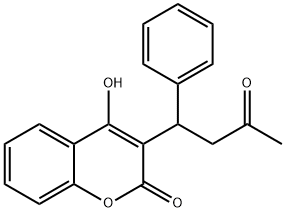Warfarin

|
| Manufacturer | Product number | Product description | Packaging | Price | Updated | Buy |
|---|
Properties
Melting point :162-164 °C(lit.)
Boiling point :356°C
Density :1.1411 (rough estimate)
vapor pressure :0.09 at 22 °C (NIOSH, 1997)
refractive index :1.4434 (estimate)
Flash point :2℃
storage temp. :2-8°C
solubility :Soluble in benzene, 1,4-dioxane (Weast, 1986), and acetone (Sax and Lewis, 1987). Moderately soluble in methanol, ethanol, isopropanol, and some oils (Windholz et al., 1983). Also soluble in toluene.
form :Crystalline
pka :pKa 4.90±0.01(H2O t = 25±0.5 I = 0.15 (KCl))(Approximate)
color :Colorless
Odor :odorless
Water Solubility :Practically insoluble
Merck :13,10097
BRN :8868198
Exposure limits :NIOSH REL: TWA 0.1 mg/m3, IDLH 100 mg/m3; OSHA PEL: 0.1 mg/m3; ACGIH TLV: TWA 0.1 mg/m3.
LogP :2.600
CAS DataBase Reference :81-81-2(CAS DataBase Reference)
NIST Chemistry Reference :3-(Alpha-acetonylbenzyl)-4-hydroxycoumarin(81-81-2)
EPA Substance Registry System :Warfarin (81-81-2)
Boiling point :356°C
Density :1.1411 (rough estimate)
vapor pressure :0.09 at 22 °C (NIOSH, 1997)
refractive index :1.4434 (estimate)
Flash point :2℃
storage temp. :2-8°C
solubility :Soluble in benzene, 1,4-dioxane (Weast, 1986), and acetone (Sax and Lewis, 1987). Moderately soluble in methanol, ethanol, isopropanol, and some oils (Windholz et al., 1983). Also soluble in toluene.
form :Crystalline
pka :pKa 4.90±0.01(H2O t = 25±0.5 I = 0.15 (KCl))(Approximate)
color :Colorless
Odor :odorless
Water Solubility :Practically insoluble
Merck :13,10097
BRN :8868198
Exposure limits :NIOSH REL: TWA 0.1 mg/m3, IDLH 100 mg/m3; OSHA PEL: 0.1 mg/m3; ACGIH TLV: TWA 0.1 mg/m3.
LogP :2.600
CAS DataBase Reference :81-81-2(CAS DataBase Reference)
NIST Chemistry Reference :3-(Alpha-acetonylbenzyl)-4-hydroxycoumarin(81-81-2)
EPA Substance Registry System :Warfarin (81-81-2)
Safety Information
| Symbol(GHS): |
  
|
|||||||||||||||||||||
|---|---|---|---|---|---|---|---|---|---|---|---|---|---|---|---|---|---|---|---|---|---|---|
| Signal word: | Danger | |||||||||||||||||||||
| Hazard statements: |
|
|||||||||||||||||||||
| Precautionary statements: |
|
Description
Warfarin is tasteless and colorless. It is a widely used as anticoagulant (which stops the blood clotting) in the treatment and prevention of thrombosis, in the treatment for chronic atrial fibrillation, mechanical valves, pulmonary embolism, and dilated cardiomyopathy. Warfarin is metabolized primarily via oxidation in the liver by CYP2C9, and exerts its anticoagulant effect by inhibiting the protein vitamin K epoxide reductase complex, subunit 1 (VKORC1). Warfarin therapy can be associated with significant bleeding complications. Achieving a safe therapeutic response can be difficult because of warfarin’s narrow therapeutic index and great individual variability in the dose required, which is mostly a consequence of individual genetic variants: it is influenced by ageing, co-prescribed drugs, diet, alcohol consumption, and comorbid conditions. To maintain a therapeutic level of anti-thrombosis and to minimize the risk of bleeding complications, warfarin therapy requires intensive monitoring via the INR to guide its dosing. It is also used as the first generation of anticoagulant rodenticides.Related product price
- 4-HYDROXY MEPHENYTOIN
₹24258.83-104560 - DICUMAROL
₹1600-19000 - 2,6-Di-tert-butyl-4-methylphenol
₹930-67040






